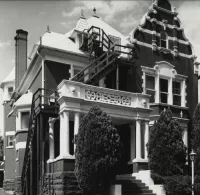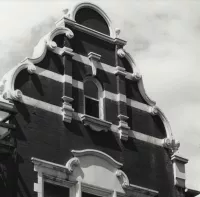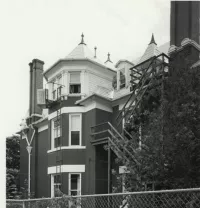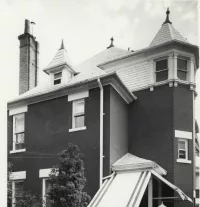Share what you know,
and discover more.
Share what you know,
and discover more.
Oct 03, 1980

-

- Charmaine Bantugan
National Register of Historic Places - Carl M. Neuhausen House
Statement of Significance: Carl M. Neuhausen was Utah's only prominent architect to employ the Chateauesque style, reflecting both his talent and his German background. Neuhausen is best known for the Cathedral of the Madeleine, the Orpheum (Promised Valley) Theatre, and the Kearns Mansion. He designed a number of buildings for the Catholic Church in Utah, most of which have been demolished. Though less elaborate than his largest residences, Neuhausen's own house reflects his skillful use of eclectic, mannerist detailing. Carl M. Neuhausen was born in Stuttgart, Germany, on October 8, 1858. He received his education from the public schools and went on to study architecture at the polytechnic institutions of Southern Germany. At 24, after having mastered the fundamentals of his profession, and having a desire to eventually come to America, he spent time in practice and in traveling through Germany in order to learn as much as possible of German architecture. After four years, at the age of 28, he came to America. For a short time he lived in Iowa, then in St. Paul, Minnesota, where he married a young woman named Julia Liblum and assisted in designing several buildings in the St. Paul area. He lived some time in Helena, Montana. The Neuhausens arrived in Salt Lake in February of 1892 and for the first three years in the valley Mr. Neuhausen worked for Richard K.A. Kletting, a prominent Salt Lake architect. Together they designed, among other buildings, the Saltair Pavilion at the Saltair Resort. On January 1, 1895, he established his own office in the old Dooly Building and earned an excellent reputation for versatility of style. He designed some of the largest structures in Salt Lake City. Among the more well-known are the Kearns Mansion, the Cathedral of the Madeleine, the Orpheum Theater (now the Promised Valley Playhouse), the Walker Bank Building, St. Ann's Orphanage, the J.D. Wood home (demolished), and the early buildings Holy Cross Hospital. Mr. Neuhausen's private life was as rich and colorful as the buildings he designed. He was an active Republican, a member of the Catholic Church, an active member of both the Knights of Columbus and the Elk's Lodge, and served two years as councilman during Mayor Richard P. Morris' administration. His wife Julia bore him eight children, four boys and four girls. On June 13, 1901, the Neuhausens acquired Building Permit #1839 to begin construction of their home on a lot near Thirteenth East and First South, for an estimated cost of $5,000. On September 22, 1907, Carl M. Neuhausen died in his home of heart failure at the age of 49. The house was kept by his widow, Julia, until 1911, at which time she sold it and a long list of ownership ensues to the present day, It was in the year 1939 when John F. Thurgood bought the home that it was initially broken down into rental units. It is unclear at what point the living area was divided into what sections, but from 1963 to the present there have been eight apartments: two in the basement, two in the attic, and two on each of the main and second story floors.
National Register of Historic Places - Carl M. Neuhausen House
Statement of Significance: Carl M. Neuhausen was Utah's only prominent architect to employ the Chateauesque style, reflecting both his talent and his German background. Neuhausen is best known for the Cathedral of the Madeleine, the Orpheum (Promised Valley) Theatre, and the Kearns Mansion. He designed a number of buildings for the Catholic Church in Utah, most of which have been demolished. Though less elaborate than his largest residences, Neuhausen's own house reflects his skillful use of eclectic, mannerist detailing. Carl M. Neuhausen was born in Stuttgart, Germany, on October 8, 1858. He received his education from the public schools and went on to study architecture at the polytechnic institutions of Southern Germany. At 24, after having mastered the fundamentals of his profession, and having a desire to eventually come to America, he spent time in practice and in traveling through Germany in order to learn as much as possible of German architecture. After four years, at the age of 28, he came to America. For a short time he lived in Iowa, then in St. Paul, Minnesota, where he married a young woman named Julia Liblum and assisted in designing several buildings in the St. Paul area. He lived some time in Helena, Montana. The Neuhausens arrived in Salt Lake in February of 1892 and for the first three years in the valley Mr. Neuhausen worked for Richard K.A. Kletting, a prominent Salt Lake architect. Together they designed, among other buildings, the Saltair Pavilion at the Saltair Resort. On January 1, 1895, he established his own office in the old Dooly Building and earned an excellent reputation for versatility of style. He designed some of the largest structures in Salt Lake City. Among the more well-known are the Kearns Mansion, the Cathedral of the Madeleine, the Orpheum Theater (now the Promised Valley Playhouse), the Walker Bank Building, St. Ann's Orphanage, the J.D. Wood home (demolished), and the early buildings Holy Cross Hospital. Mr. Neuhausen's private life was as rich and colorful as the buildings he designed. He was an active Republican, a member of the Catholic Church, an active member of both the Knights of Columbus and the Elk's Lodge, and served two years as councilman during Mayor Richard P. Morris' administration. His wife Julia bore him eight children, four boys and four girls. On June 13, 1901, the Neuhausens acquired Building Permit #1839 to begin construction of their home on a lot near Thirteenth East and First South, for an estimated cost of $5,000. On September 22, 1907, Carl M. Neuhausen died in his home of heart failure at the age of 49. The house was kept by his widow, Julia, until 1911, at which time she sold it and a long list of ownership ensues to the present day, It was in the year 1939 when John F. Thurgood bought the home that it was initially broken down into rental units. It is unclear at what point the living area was divided into what sections, but from 1963 to the present there have been eight apartments: two in the basement, two in the attic, and two on each of the main and second story floors.
Oct 03, 1980
National Register of Historic Places - Carl M. Neuhausen House
Statement of Significance:
Carl M. Neuhausen was Utah's only prominent architect to employ the Chateauesque style, reflecting both his talent and his German background. Neuhausen is best known for the Cathedral of the Madeleine, the Orpheum (Promised Valley) Theatre, and the Kearns Mansion. He designed a number of buildings for the Catholic Church in Utah, most of which have been demolished. Though less elaborate than his largest residences, Neuhausen's own house reflects his skillful use of eclectic, mannerist detailing.
Carl M. Neuhausen was born in Stuttgart, Germany, on October 8, 1858. He received his education from the public schools and went on to study architecture at the polytechnic institutions of Southern Germany. At 24, after having mastered the fundamentals of his profession, and having a desire to eventually come to America, he spent time in practice and in traveling through Germany in order to learn as much as possible of German architecture. After four years, at the age of 28, he came to America.
For a short time he lived in Iowa, then in St. Paul, Minnesota, where he married a young woman named Julia Liblum and assisted in designing several buildings in the St. Paul area. He lived some time in Helena, Montana.
The Neuhausens arrived in Salt Lake in February of 1892 and for the first three years in the valley Mr. Neuhausen worked for Richard K.A. Kletting, a prominent Salt Lake architect. Together they designed, among other buildings, the Saltair Pavilion at the Saltair Resort.
On January 1, 1895, he established his own office in the old Dooly Building and earned an excellent reputation for versatility of style. He designed some of the largest structures in Salt Lake City. Among the more well-known are the Kearns Mansion, the Cathedral of the Madeleine, the Orpheum Theater (now the Promised Valley Playhouse), the Walker Bank Building, St. Ann's Orphanage, the J.D. Wood home (demolished), and the early buildings Holy Cross Hospital. Mr. Neuhausen's private life was as rich and colorful as the buildings he designed. He was an active Republican, a member of the Catholic Church, an active member of both the Knights of Columbus and the Elk's Lodge, and served two years as councilman during Mayor Richard P. Morris' administration. His wife Julia bore him eight children, four boys and four girls.
On June 13, 1901, the Neuhausens acquired Building Permit #1839 to begin construction of their home on a lot near Thirteenth East and First South, for an estimated cost of $5,000.
On September 22, 1907, Carl M. Neuhausen died in his home of heart failure at the age of 49. The house was kept by his widow, Julia, until 1911, at which time she sold it and a long list of ownership ensues to the present day,
It was in the year 1939 when John F. Thurgood bought the home that it was initially broken down into rental units. It is unclear at what point the living area was divided into what sections, but from 1963 to the present there have been eight apartments: two in the basement, two in the attic, and two on each of the main and second story floors.
Posted Date
Jul 03, 2023
Historical Record Date
Oct 03, 1980
Source Name
National Register of Historic Places
Source Website
Delete Story
Are you sure you want to delete this story?













